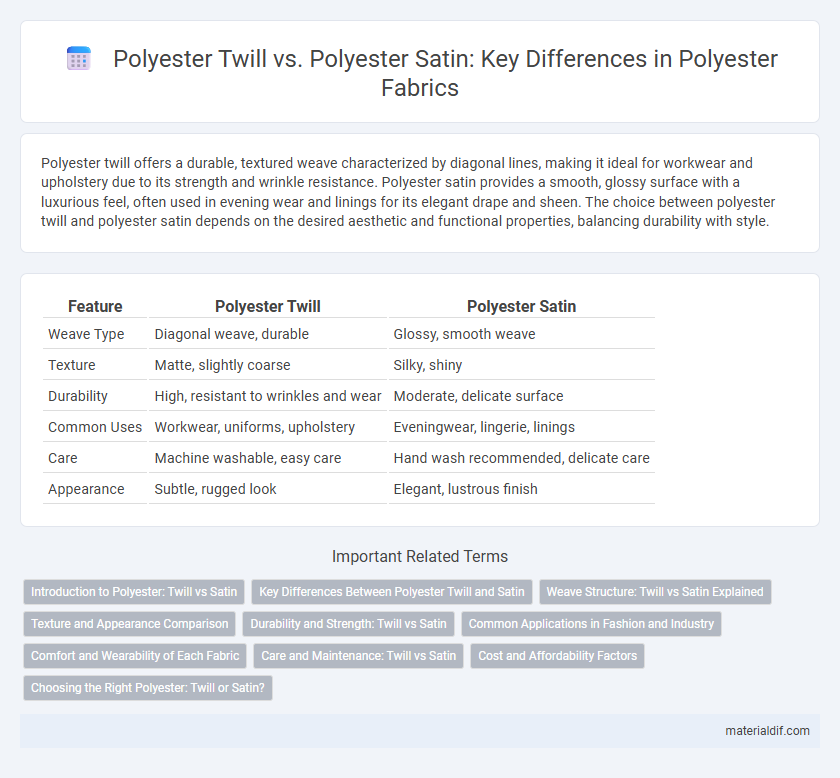Polyester twill offers a durable, textured weave characterized by diagonal lines, making it ideal for workwear and upholstery due to its strength and wrinkle resistance. Polyester satin provides a smooth, glossy surface with a luxurious feel, often used in evening wear and linings for its elegant drape and sheen. The choice between polyester twill and polyester satin depends on the desired aesthetic and functional properties, balancing durability with style.
Table of Comparison
| Feature | Polyester Twill | Polyester Satin |
|---|---|---|
| Weave Type | Diagonal weave, durable | Glossy, smooth weave |
| Texture | Matte, slightly coarse | Silky, shiny |
| Durability | High, resistant to wrinkles and wear | Moderate, delicate surface |
| Common Uses | Workwear, uniforms, upholstery | Eveningwear, lingerie, linings |
| Care | Machine washable, easy care | Hand wash recommended, delicate care |
| Appearance | Subtle, rugged look | Elegant, lustrous finish |
Introduction to Polyester: Twill vs Satin
Polyester twill features a distinctive diagonal weave pattern that offers durability and a textured surface, making it ideal for sturdy applications like uniforms and workwear. Polyester satin, on the other hand, has a smooth, glossy finish created by a weave that maximizes yarn exposure, producing a lustrous and elegant appearance often used in formalwear and linings. Both fabrics leverage polyester's strength and synthetic fibers, but their weaving styles significantly influence their texture, sheen, and typical uses.
Key Differences Between Polyester Twill and Satin
Polyester twill features a diagonal weave that enhances durability and gives the fabric a textured appearance, making it ideal for workwear and upholstery. In contrast, polyester satin exhibits a smooth, glossy surface due to its unique weave that reflects light, often used in evening wear and lingerie. The primary differences lie in texture, sheen, and typical applications, where twill offers sturdiness and satin provides elegance and softness.
Weave Structure: Twill vs Satin Explained
Polyester twill features a diagonal weave pattern that enhances durability and wrinkle resistance, making it ideal for workwear and upholstery. Polyester satin has a smooth and glossy surface created by a weave with more yarns floating on the fabric face, offering a luxurious appearance suited for evening wear and linings. The twill weave produces a textured, sturdy fabric, while the satin weave yields a sleek, shiny finish due to its yarn arrangement.
Texture and Appearance Comparison
Polyester twill features a distinctive diagonal weave that creates a textured surface with enhanced durability and a matte finish, making it ideal for workwear and uniforms. Polyester satin displays a smooth, glossy surface with a sleek, reflective sheen achieved through a satin weave, offering a luxurious appearance suitable for fashion and formal wear. The key difference lies in polyester twill's pronounced texture and muted luster versus polyester satin's smooth feel and high shine.
Durability and Strength: Twill vs Satin
Polyester twill features a diagonal weave pattern that enhances durability and tensile strength, making it resistant to wear and tear in heavy-use applications. Polyester satin, with its smooth and glossy surface created by a satin weave, tends to be less durable but offers a softer hand feel and better drape. For projects requiring long-lasting strength, polyester twill outperforms satin due to its robust fiber interlacing that withstands abrasion and stress.
Common Applications in Fashion and Industry
Polyester twill's diagonal weave makes it ideal for durable, wrinkle-resistant garments such as uniforms, workwear, and casual outerwear, providing strength and a matte finish favored in industrial applications. Polyester satin's smooth, glossy surface offers a luxurious appearance, commonly used in evening wear, lingerie, and formal dresses, as well as decorative linings and upholstery in fashion and interior design. Both fabrics leverage polyester's moisture-wicking and quick-drying properties but differ in texture and aesthetic, influencing their specific uses across fashion and industrial sectors.
Comfort and Wearability of Each Fabric
Polyester twill features a diagonal weave that provides durability and a slightly textured surface, making it breathable and comfortable for everyday wear. Polyester satin offers a smooth, glossy finish with a tight weave, resulting in a soft feel but less breathability compared to twill. While twill excels in wearability for active or prolonged use due to moisture-wicking properties, satin is preferred for formal or aesthetic-focused garments where comfort is balanced with elegance.
Care and Maintenance: Twill vs Satin
Polyester twill fabric is more durable and resistant to wrinkles, making it easier to care for with simple machine washing and minimal ironing. Polyester satin requires gentler handling due to its smooth, shiny surface which can snag or show wear; it is best washed on a delicate cycle and often benefits from hand washing or dry cleaning. Both fabrics dry quickly, but satin needs extra attention to prevent heat damage during ironing, often necessitating a low-temperature or steam setting.
Cost and Affordability Factors
Polyester twill typically costs less than polyester satin due to its simpler weave and lower production complexity, making it a more affordable option for bulk garment manufacturing and upholstery projects. Polyester satin's smoother, glossier finish requires specialized weaving techniques that increase production expenses, thereby raising its market price and limiting its accessibility for budget-conscious consumers. Price differences between polyester twill and satin fabrics are influenced by factors such as yarn quality, weave tightness, and finishing treatments, which affect overall durability, texture, and visual appeal.
Choosing the Right Polyester: Twill or Satin?
Polyester twill features a diagonal weave that provides durability and a textured finish, ideal for workwear and upholstery, while polyester satin offers a smooth, glossy surface perfect for formal garments and elegant drapery. Selecting the right polyester depends on the end use--twill excels in strength and wrinkle resistance, whereas satin prioritizes sheen and softness. Consider the fabric's application, desired aesthetic, and performance needs when choosing between polyester twill and satin.
Polyester Twill vs Polyester Satin Infographic

 materialdif.com
materialdif.com